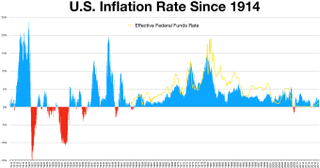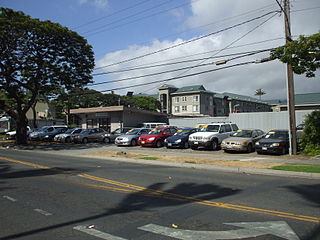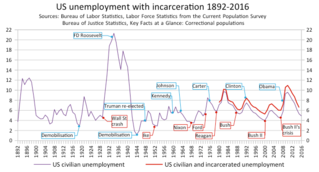Related Research Articles

In economics, inflation is a sustained increase in the general price level of goods and services in an economy over a period of time. When the general price level rises, each unit of currency buys fewer goods and services; consequently, inflation reflects a reduction in the purchasing power per unit of money – a loss of real value in the medium of exchange and unit of account within the economy. The opposite of inflation is deflation, a sustained decrease in the general price level of goods and services. The common measure of inflation is the inflation rate, the annualized percentage change in a general price index, usually the consumer price index, over time.

Monetary policy concerns the actions of a central bank or other regulatory authorities that determine the size and rate of growth of the money supply. For example, in the United States, the Federal Reserve is in charge of monetary policy, and implements it primarily by performing operations that influence short-term interest rates.

A Consumer Price Index measures changes in the price level of a weighted average market basket of consumer goods and services purchased by households.
The Corporate Average Fuel Economy (CAFE) standards are regulations in the United States, first enacted by the United States Congress in 1975, after the 1973–74 Arab Oil Embargo, to improve the average fuel economy of cars and light trucks produced for sale in the United States. They are set by the Secretary of Transportation, currently Elaine Chao, via the National Highway Traffic Safety Administration.
In a tax system, the tax rate is the ratio at which a business or person is taxed. There are several methods used to present a tax rate: statutory, average, marginal, and effective. These rates can also be presented using different definitions applied to a tax base: inclusive and exclusive.

The term annual percentage rate of charge (APR), corresponding sometimes to a nominal APR and sometimes to an effective APR (EAPR), is the interest rate for a whole year (annualized), rather than just a monthly fee/rate, as applied on a loan, mortgage loan, credit card, etc. It is a finance charge expressed as an annual rate. Those terms have formal, legal definitions in some countries or legal jurisdictions, but in general:

Politicians and pundits frequently refer to the ability of the President of the United States to "create jobs" in the U.S. during his term in office. The numbers are most often seen during the election season or in regard to a President's economic legacy. The numbers typically used and most frequently cited by economists are total nonfarm payroll employment numbers as collected by the Bureau of Labor Statistics on a monthly and annual basis. The BLS also provides numbers for private-sector non-farm employment and other subsets of the aggregate that are more useful for making points.
Foreign exchange reserves are cash and other reserve assets held by a central bank or other monetary authority that are primarily available to balance payments of the country, influence the foreign exchange rate of its currency, and to maintain confidence in financial markets. Reserves are held in one or more reserve currencies, nowadays mostly the United States dollar and to a lesser extent the euro.
Annual average daily traffic, abbreviated AADT, is a measure used primarily in transportation planning, transportation engineering and retail location selection. Traditionally, it is the total volume of vehicle traffic of a highway or road for a year divided by 365 days. AADT is a simple, but useful, measurement of how busy the road is. Newer advances from GPS traffic data providers are now providing AADT counts by side of the road, by day of week and by time of day.
In economics, valuation using multiples, or “relative valuation”, is a process that consists of:

Transportation safety in the United States encompasses safety of transportation in the United States, including automobile accidents, airplane crashes, rail crashes, and other mass transit incidents, although the most fatalities are generated by road accidents.

A used car, a pre-owned vehicle, or a secondhand car, is a vehicle that has previously had one or more retail owners. Used cars are sold through a variety of outlets, including franchise and independent car dealers, rental car companies, buy here pay here dealerships, leasing offices, auctions, and private party sales. Some car retailers offer "no-haggle prices," "certified" used cars, and extended service plans or warranties.
Seasonal adjustment or deseasonalization is a statistical method for removing the seasonal component of a time series. It is usually done when wanting to analyse the trend, and cyclical deviations from trend, of a time series independently of the seasonal components. It is normal to report seasonally adjusted data for unemployment rates to reveal the underlying trends and cycles in labor markets. Many economic phenomena have seasonal cycles, such as agricultural production and consumer consumption, e.g. greater consumption leading up to Christmas. It is necessary to adjust for this component in order to understand underlying trends in the economy, so official statistics are often adjusted to remove seasonal components.

The Great Recession was a period of marked general decline (recession) observed in national economies globally during the late 2000s. The scale and timing of the recession varied from country to country. The International Monetary Fund (IMF) formerly concluded that it was the most severe economic and financial meltdown since the Great Depression.
While beginning in the United States, the Great Recession spread to Asia rapidly and has affected much of the region.
North America was one of the focal points of the global, Great Recession. While Canada has managed to return its economy nearly to the levels it enjoyed prior to the recession, the United States and Mexico are still under the influence of the worldwide economic slowdown. The cost of staple items dropped dramatically in the United States as a result of the recession.
As a direct result of the late 2000s recession, some economies in Africa have been primarily affected by reduced global demand and lower prices of commodities such as oil, platinum, nickel, gold, and copper. South Africa was the first African country to fall in recession. Other countries like Morocco and Egypt, which benefited from their previous high economic growth experienced a great decline due to the global economic crisis without falling in recession.

The automotive industry in the United States began in the 1890s and, as a result of the size of the domestic market and the use of mass production, rapidly evolved into the largest in the world. However, the United States was overtaken as the largest automobile producer by Japan in the 1980s, and subsequently by China in 2008. The U.S. is currently second among the largest manufacturer in the world by volume, with approximately 8-10 million manufactured annually. Notable exceptions were 5.7 million automobiles manufactured in 2009, and peak production levels of 13-15 million units during the 1970s and early 2000s.

Unemployment in the United States discusses the causes and measures of U.S. unemployment and strategies for reducing it. Job creation and unemployment are affected by factors such as economic conditions, global competition, education, automation, and demographics. These factors can affect the number of workers, the duration of unemployment, and wage levels.
References
- ↑ "Light Weight Vehicle Sales: Autos and Light Trucks". Federal Reserve Bank of St. Louis. 9 November 2016. Retrieved 15 November 2016.
- ↑ "Federal Reserve Seasonal Factors for Domestic Auto and Truck Production: formulas". Federal Reserve. 1 April 2016. Retrieved 15 November 2016.